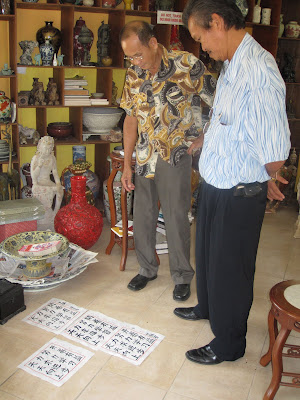KUANTAN: Nestled within a 6ha plot of private land off Jalan Sungei Lembing near here is the famed Lao Zi temple.
Every year, close to 100,000 visitors drop in here to pay homage to the founder of Taoism.
 |
Impressive: The head of the dragon from where visitors will emerge after their walk. |
The main attraction of the temple is a sculpture of the Golden Dragon, reputed to be the longest in the world. Visitors are taken on a guided tour inside the dragon, going in through its tail and coming out from its mouth.
It takes about 15 minutes to walk the 823m path.
Written on the walls are a 5,000- word scripture, known as the “Book of Tao and its Virtues.”
 |
A pair of longevity and prosperity tortoises in the temple. |
The temple’s caretaker Kui Fook Weng, 39, said it was a common belief that when a person comes out from the dragon’s mouth, he would be blessed with good fortune. He said visitors would be asked to make a wish and touch the dragon’s pearl, strategically perched in front of its majestic head.
“The dragon sculpture cost a whopping RM550,000 derived from my father’s personal savings and public donations.
“Work started in 2000 and was completed after three years,” he said in an interview.
 |
New attraction: Wai Pong showing the 18-levels of hell which he will erect in the temple’s premises by August next year. |
Fook Weng said the land where the temple’s sits was inherited from his grandfather and developed by his father. Among the other attractions are the sculpture of Lao Zi measuring 7m high, a fish pond surrounded by 12 animals from the Chinese zodiac, brass image of the Goddess of Mercy dating back to the Ming dynasty, a wishing bell, a pair of longevity and prosperity tortoises, a pair of “Earth” dragons, images of the 18 Lo Hans (arhats) and the prosperity Buddha.
There is also a beautiful landscaped garden with fruit trees, rocks inscribed with words of wisdom and a house of antiques.
Most of the antiques are of Chinese origin comprising porcelain wares, ancient stone carving, brassware and other rare artefacts.
Fook Weng said most of their visitors were tour groups on a day-trip to Kuantan, adding that they sometimes had tourists from Singapore during weekends.
According to the temple’s founder Kui Wai Pong, 70, the origin of Taoism and Confucianism could be traced back to the Zhou dynasty (1122 to 221 BC).
 |
Attention to detail: One of the many sculptures in the temple. |
Lao Zi was then the head of the state library and much of his time was devoted to learning through self-effacement and without fame. After witnessing the decline of the Zhou dynasty, Lao Zi departed on an oxen to travel westward.
In response to a request from Yinxi – a guardian of the Western Pass – Lao Zi wrote a book in two sections dealing with Tao religion.
In later times, the book became the most important scripture of Taoism and hence, Lao Zi was widely regarded as the founder.
Wai Pong dedicates his time and resources to looking after the temple with his eldest son Fook Weng.
Occasionally, he travels to Thailand and Myanmar for religious activities and to scout for Chinese herbs, leaving his son to take charge of the temple’s affairs.
Wai Pong has been a sinseh and a medium, providing guidance and advice to followers over the past 50 years.
 |
Must-see: Some of the antiques in the temple. |
“I started to actively expand the temple in 1998 after receiving an intuition to construct a golden dragon. “My next aim is to build an image of the 18 levels of hell at a cost of RM360,000,” he said, adding that he had already raised the money and was awaiting for the material from China to commence work by August next year.
He said the image of hell was to remind the people to do good as they would have to pay for their bad deeds in the “other world.”
Wai Pong said although the temple was located in a secluded area, many people would congregate in the premises for religious activities held at least twice a year.
For more information on the temple or to arrange for a guided tour, contact Fook Weng at 019-948 2020 or 016-936 2629.
Original article from The Star, written by SIMON KHOO







































 09年华小学生书法邀请赛于昨天(08.08.2009)成功举行,并邀请到YB拿督彭子明,拿督符志宾和张伟标为贵宾。当天共有9所华小,(培才华小,光华华小,中菁华小,士满幕华小,公民华小,班珍华小,培民华小,和育贤华小)参与这一次的华小学生书法邀请赛。
09年华小学生书法邀请赛于昨天(08.08.2009)成功举行,并邀请到YB拿督彭子明,拿督符志宾和张伟标为贵宾。当天共有9所华小,(培才华小,光华华小,中菁华小,士满幕华小,公民华小,班珍华小,培民华小,和育贤华小)参与这一次的华小学生书法邀请赛。 书法邀请赛现场
书法邀请赛现场
 开幕仪式
开幕仪式 司仪,丘福荣先生
司仪,丘福荣先生
 太上老君庙的创办人
太上老君庙的创办人 贵宾们的合照,由左到右(黄森顺,张伟标,拿督符志宾,YB拿督彭子明,丘尉邦师父)
贵宾们的合照,由左到右(黄森顺,张伟标,拿督符志宾,YB拿督彭子明,丘尉邦师父) 奖品
奖品 孔子塑像与奖品
孔子塑像与奖品 两位评判与参赛者的书法
两位评判与参赛者的书法 两位评判的合照
两位评判的合照
 师父(公公)与秀娟(孙女)的合照
师父(公公)与秀娟(孙女)的合照 师父(公公)与岳权(孙子)的合照
师父(公公)与岳权(孙子)的合照 师父(公公)与碧凤(孙女)的合照
师父(公公)与碧凤(孙女)的合照
 合照
合照 大合照
大合照 A组冠,亚,季军的合照
A组冠,亚,季军的合照 A组冠军 - 张净龙同学(公民小学)
A组冠军 - 张净龙同学(公民小学) A组季军 - 黎全晟(培才华小)
A组季军 - 黎全晟(培才华小) A组季军 - 黎骁庆(培才华小)
A组季军 - 黎骁庆(培才华小) B组冠,亚,季军的合照
B组冠,亚,季军的合照 B组冠军 - 陈咏晴(公民小学)
B组冠军 - 陈咏晴(公民小学) B组亚军 - 陈诗慧(公民华小)
B组亚军 - 陈诗慧(公民华小) B组季军 - 林敬宥(育贤华小)
B组季军 - 林敬宥(育贤华小)